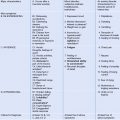CHAPTER 55 Vocational Considerations
Introduction
Immigrants make up an increasing proportion of the US workforce. Approximately 25% of the US population is either born outside of the United States or a child of someone born outside of the United States. Over one-half of the foreign-born come from Latin America (53%), one-quarter from Asia, 13% from Europe, and 8% from Africa, Oceania, and elsewhere. As the native work population is aging, the contributions of the foreign-born labor force are becoming more significant. Moreover, immigrants contribute to the tax base of the economy1 as well as to the American Social Security System.2 Immigrants tend to live at both ends of the social spectrum. In 2004, four-tenths of all scientists were foreign-born (38%), as were three-tenths of those with a Master’s degree.3 At the same time, according to 2004 estimates, foreign-born workers gravitated toward farming, fishing, and forestry (41%), building, grounds cleaning, and maintenance (33%), food preparation and serving (22%), computer and mathematical occupations (19%), and life, physical, and science occupations (17%).4 Although some immigrants may not find the transition to the US difficult, for others the differences between the society they left behind and the society they have entered can present significant obstacles to successful employment.
Across generations and across cultures, families strive to provide a better life for their children and the families they left behind in their own countries. For example, in 2003, gross flows to developing countries amounted to US$142 billion, compared to US$18.4 billion in 1980. The annual average figure increased from US$7.8 million in 1975–1979 to a recorded total of US$98 billion in 1998–2003. According to World Bank projections, international remittances received by developing countries were expected to reach US$167 billion in 2005 – a more than ninefold increase over the past 25 years.5 Between 2000 and 2003, new immigrants accounted for more than half of the job growth in the nation’s labor force.6 Despite their high rate of participation in the job market, in many cases their wages and job benefits are low.7 In practical terms, this often translates into working long hours and two or three jobs in an effort to provide.
Employment Barriers
Barriers to employment of immigrants include language barriers, inability to transfer qualifications in the country of origin to the US, differences in culturally-shaped work ethic, influence of the family on career selection, lack of sufficient job skills, mismatch between qualifications and expectations, and misperceptions about the process of applying for a job, interviewing, and keeping a job.8–13 Poor health may also be a barrier to employment, and some of the types of employment found by immigrants may pose health hazards (see Ch. 57). Underemployed workers report lower levels of health and well-being,14 and the effect on health seems to be greater for immigrant women than for immigrant men.15 Immigrants who have experienced trauma may face additional challenges including lack of trust of authority figures, difficult living situations, lack of family or group support, and mental health issues that interfere with successful functioning on the job. Language skills are particularly central as described in a paper highlighting challenges faced by Bosnian refugees resettling in Sweden.16 For Southeast Asians in Canada, even 10 years after resettlement, language fluency was a significant predictor of depression and lack of employment, particularly among refugee women and among people who did not become engaged in the labor market during their earliest years of resettlement.17 In the same population, job loss was also shown to lead to an increased risk of depression, leading to more difficulty staying employed.18 Among Iraqi asylum seekers in Sweden, lack of work, family issues, and the asylum process itself were positively associated with psychopathology.19
Different barriers to the work force exist across ethnic groups. Immigrants may arrive with differences in educational attainment, family composition, work experience, vocational training, English language fluency, and ability to drive.20–22 Previous life experiences can also serve as barriers. Attitudes in the host culture and in the workplace environment can affect how newcomers adapt. Immigrants may face stereotyping.23 New experiences such as competition, territoriality, and interaction fatigue can make adjustment to the workplace especially challenging.24 Many newcomers have expectations of what the United States would be like, and these may not match the reality they must face.24
Many of the stresses associated with resettlement in a new country affect the process of employment. Stress is created by acculturative tasks such as learning a new language, seeking employment, rebuilding social supports, and defining roles.21 Culture shock and loss of status have been shown to affect general adjustment of immigrants and refugees.25 The migrant process also raises issues related to security and comfort, self-worth and self-acceptance, competence, identity and belonging, and the meaning of life.26 Some immigrants miss the emotional support of loved ones left behind and the former cultural way of life27 as they are simultaneously challenged by employment. Changes in family dynamics can occur in a new country when men formerly with high status struggle with establishing themselves, and their wives become breadwinners.28 Others remain isolated until improving their English skills and upgrading their employment status, which later enhances integration.29
In an effort to cope with barriers, immigrants may use both family and ethnic groups as resources to search for employment. Those who enlist the aid of families and trusted groups often obtain higher-quality employment than those who rely on themselves. Though these networks are helpful in employment adjustment, they are not always able to compensate for downward occupational mobility and societal restrictions related to credentialing.30 In fact, some investigators have found that social networks, workplace ethnic composition, and informal and formal assistance have minimal impact on economic adaptation.31 The prevailing job market has an important effect on employment of immigrants, as differences in employment rate probabilities between recent immigrants and non-immigrants heightened in recession years.32,33
Trauma and Work
As a result of war and human rights violations, some newcomers may come to the United States with significant histories of trauma experienced in their countries of origin and during flight. Although many exhibit extraordinary resilience, a trauma history can be predictive of post-traumatic stress disorder (PTSD), which may negatively influence quality of life and self-sufficiency.34 In asylum seekers, PTSD has been associated with premigration trauma, delay in processing refugee applications, obstacles to employment, racial discrimination, loneliness, and boredom.35 A significant relationship has been shown between trauma variables and employment status. For example, among Cambodians, those who continued to have disturbing thoughts about their trauma and spent more time in refugee camps were more likely to be unemployed. The number of years in the refugee camp did not predict income or health.36 Trauma can affect one’s ability to make social connections. Social supports have been shown to affect economic adaptation differently than psychological adaptation.37
The Potential Role for Vocational Rehabilitation for Immigrants
Modern vocational rehabilitation now concentrates on several main components: community-based integrated work, individual choice and decision-making, meaningful work and full participation, flexible customized supports, and career-oriented employment. Goals include the ability for immigrants to choose the career paths they desire and receive the supports necessary to accomplish their goals. Current vocational rehabilitation programs emphasize supported education and employment. Integrating supported education and employment into one program allows people to explore their career options, obtain the required education and employment skills, and finally seek and maintain employment in their chosen field. It allows each aspect to serve as a counterpart to the other, to link one goal to another, and to offer an extensive continuum of choices and services.38 Programs following the supported education and training model centralize both short- and long-term educational and vocational goals, maximizing choice, increasing competency, and offering unconditional support. Achieving empowerment and normalization – making individual decisions and reaching goals, fully participating in the process of attaining those goals, achieving those goals in mainstream society, and determining for oneself how much support and assistance is needed to maintain those successes – is the core theory behind vocational rehabilitation services.
Preparation for Work
Assessing work history and expectations about employment
Information about the home environment may be helpful when assisting immigrants with the employment process. The home environment affects the ability as well as the willingness of the individual to seek and keep a job. Immigrants may be living in borrowed space and relying on the host and others for food, money for transportation, and other items such as winter clothing. Whether there is access to enough food and a comfortable place to rest and sleep can affect alertness and physical stamina. In addition, pressures may be placed on immigrants by their hosts to find work that may not be appropriate, simply to produce an immediate income to pay to the host.
The interview
Immigrants and the native born both carry their cultural teachings and habits with them to the job site but may be unaware that in some settings the message conveyed may be different from the intended message. Many immigrants, as well as people native to the US, are not aware that they are speaking by way of body motion and positioning. Sitting slouched over or leaning into the side of a chair may mean a lack of concern with appearance or a lack of interest in what the interviewer is saying. Looking away from the interviewer or looking at the floor while speaking could make an interviewer think the applicant is avoiding something or not being truthful. Excessive hand and arm motioning may mean anxiety and can be distracting. Holding tightly to the armrests of the chair may suggest nervousness. Crossing the arms over the chest while the interviewer is speaking may imply lack of belief or interest in what the interviewer is saying. A stern, fixed facial expression or a frown could imply a difficult attitude or give the impression of a lack of cooperation. A very smiley, flighty expression could indicate a lack of seriousness or an effort to try too hard to make a positive impression. Potential cultural conflicts between individuals can relate not only to body language but also to personal space.39 Interpretations of cues are often so automatic and neurologically imbedded in one’s own culture that specific attention has to be paid toward addressing awareness to the cultural context in which these responses occur in order not to misunderstand their meaning.40
Stay updated, free articles. Join our Telegram channel

Full access? Get Clinical Tree







